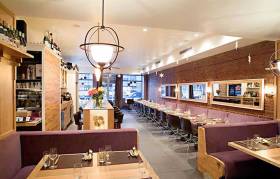The old cliché, “Unless you’re in it – then you don’t really know,” always tends to hold a significant level of truth in our line of work. The fact is, unless you have worked in the service industry, then you truly don’t understand what it is like. It is an often overly demanding profession that is rivaled only by professionals in the medical field. Yet, it is this grueling side of the service industry that draws many of us into it, keeps us in it, and fuels our addiction. The pace of our industry is the cocaine and we become addicted to it.
The paces of the restaurant industry can certainly be debilitating at times. However, that pace is what keeps all of us going. It acts as adrenaline. There is nothing quite like a dinner rush at a busy restaurant. The hustle, the bustle, the controlled (sometimes organized) chaos – it is a thing of beauty.
As a chef, we live for those moments. Once the doors open, tickets start to flood in, your chef starts barking orders at you and under all the commotion there’s a rhythm to it – a heartbeat. Like a well-oiled machine all the line cooks work in harmony and continue to produce fine product despite the surge of tickets coming in. The feeling of having your back against the wall is common during a dinner rush, but on the hot line the joy is the pressure of pulling together and kicking the rush right back in the face. When a kitchen is running all on all pistons then the camaraderie of the kitchen grows –the ability to handle the rush, as a team, it helps fuel the adrenaline and the addiction to this industry.
For servers, they may not enjoy the pace as much as chefs do, but they certainly are not immune to the addictive side of it either. Front of house staffs have to deal with the customers, the occasional pompous knuckleheads, or the devastating late night five-top; a completely different side of the beast. However, that fixating side of the industry is still present even outside of the kitchen. The front of house may not be as team oriented as a kitchen, but make no mistake the obsessive desire to make money keeps servers/bartenders/hostesses there.
The rush is a bit different for them since they work slightly independent of each other. Essentially, their shift is a sprint. Work your rear off, the faster you move means the more tables you’ll get. More tables typically will mean more money (although that isn’t always the case as most servers already know). I use the term sprint here because most servers work (on average) shorter shifts than the guys on the line. So, they are dealing with a ‘get in and get out’ mentality, which happens to also be a double-edged sword for their wallet. The addictive side for most front-of-house members is the money-making side. Most servers will make more in a six-hour shift than most individuals do in a routine 9-5 day. Despite the egregious hours one cannot deny that ability to dash around tables and bolt out with a decent chunk of change certainly keeps most servers content.
Yet, somehow between both sides of a restaurant the uniquely addictive side of it is, the afterhours. With the long work weeks, the doubles, the holidays, and all the pain-in-the-ass customers those after shift drinks and shared days off are what truly make this industry addictive. The twilight hours are when a restaurant’s staff truly comes together. The initial round serves as a venting drink. A round where everyone will vent and clear their heads about the recently finished shift. Everything after that first round is well, let’s just say, ‘kitchen confidential.’ This period of post-shift reflection is where one will notice that this profession isn’t all that bad. Everyone is dealing with the same issues – long days, time away from their family, and everyone’s schedules differ from the rest of their friends outside of the business. It is nights like these that FOH/BOH members begin to feel that family vibe of the industry. It is what truly makes the industry, so astoundingly unique.
After all, everyone in the industry understands how exhaustively brutal it is. If there isn’t a sense of camaraderie in your restaurant then it is going to make each shift that much more difficult. When that unity isn’t there the stress of this profession takes a hold and can eat everyone alive. The days become longer, the shifts move slower, and the ‘fun’ part of this job becomes non-existent.
When the kitchen understands each other and the servers communicate with one another the entire restaurant acts as one cognitive unit. When both sides of a restaurant understand each other and everyone is punching the rush in the face than that is when you see everyone falling in love with a bastard of a profession. Being a chef, being a server, being a bartender, being a hostess it can be deplorable at times, but when you have a fellowship around you it makes the grim side of things bearable. You begin to look forward to talking about the insanity of a Friday night with your fellow closers that night. You eagerly prep your station in anticipation to clearing the 400 reservations with the rest of the line. You look forward to working with your adopted family; your brothers-in-arms – you realize that you’re addicted to this lifestyle and it isn’t a bad thing.


